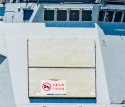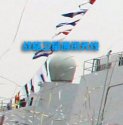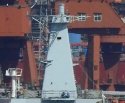Via LKJ86, an by yankeesama.
Continued below.
The new fighting capacity of 10000 ton drive is not whether the pit number is 112 or 128.
Original: Yankee frame station today
This (August 24) morning, the first ship of the 055-type guided missile destroyer, constructed by Jiangnan Changxing Shipyard, left the Changxing Island outfitting dock under the towing of a tugboat to begin the initial voyage test.
The ship belonging to a destroyer detachment of the North Sea Fleet was launched on June 28 last year, and it took 422 days from the launch to the first voyage test (the 052D first ship "Kunming" was launched from the launch to the first navigation test for about 12 months). As a brand new large-scale main battleship ship, the ship's equipment installation is much larger than the previous models. The integrated RF mast has increased the integration of various types of equipment to a whole new level.
In addition to strategic satellite antennas and navigation radars that comply with international maritime standards, the 055 type radar and communication antennas are basically integrated in the superstructure. It is the first surface warship of our military to apply integrated radio design. Not only the performance of the advanced nature of electronic equipment, but also the overall stealth effect of the entire ship.
The 346A radar of 052D is usually installed at the later stage of outfitting. [caption under a photo of 052D]
Similar to our existing "drive through" 052D, the 055 destroyer has also adopted the 346A improved radar as the main radar. Before launching the 052C/D model in Jiangnan Changxing, the antenna was usually not equipped with a four-sided phased array radar antenna, and the cover plate was used to cover the installation position of the radar, and the antenna was installed in place during the outfitting process.


The 346A improved radar has been installed in place when the ship is launched
Although the position of the phased array radar of the ship was also covered by the cover plate not long ago, the label of "precious equipment, no collision" clearly shows that the internal radar has already been installed. Recalling that when the ship was launched, the photo showed that at least the first two sides of the ship's 346 modified radar antenna were already in place. This unprecedented high-loading degree is not only the guarantee of the speed of ship construction, but also a side of the further improvement of Jiangnan's construction technology.
During the RIMPAC-2016 exercise, the US side gave a very high evaluation of the construction technology of the 153 ship. [caption under a photo from RIMPAC]
When it comes to the guided missile destroyer built by Jiangnan, during the "Pacific Rim-2016" exercise, the US personnel visited the 153 ships that we participated in and concluded that the construction level of the ship is no less than or even exceeded. The General Dynamics Bass Steel Shipyard, which built the "Arleigh Burke" series of destroyers (of course, is not a business blower, everyone can be different).


The fusion of multiple data link antennas means that 055 is not only the battle node for formation attack and defense, but also the core of command and information fusion. [the text on the photos remains to be translated]
Compared to the more focused X-band phased array radar and the meter-wave phased array alert radar, the number of auxiliary electronic antennas on 055 is relatively small. Before the people's Navy all types of ships equipped with a generation of joint data chain (J-chain) antenna, on the 055, it became a four-solid planar antenna integrated into the mast, and the first long wave data link antenna on our ship meant that the 055 type became the first type three data chain of the People's Navy (J chain, uhf/ VHF chain, satellite chain).
The rod antenna at the ends of the mast of the 054A missile frigate is the J-chain antenna on the three-generation ship of our navy and the modified old ship.
The joint military data link (joint information distribution system, JIDS), commonly known as the J chain, was prepared for the service of military struggle at the beginning of this century. It was developed with reference to the US Army Link-16, which initially enabled our military to achieve joint communication on the data. Although the J chain has initially completed the interconnection and interoperability of our military units, due to the early development and equipment time of the project, some important indicators such as bandwidth and performance are still behind the contemporary US military equipment. Moreover, other deficiencies have been exposed in use, such as the problem of information jam.
Continued below.








